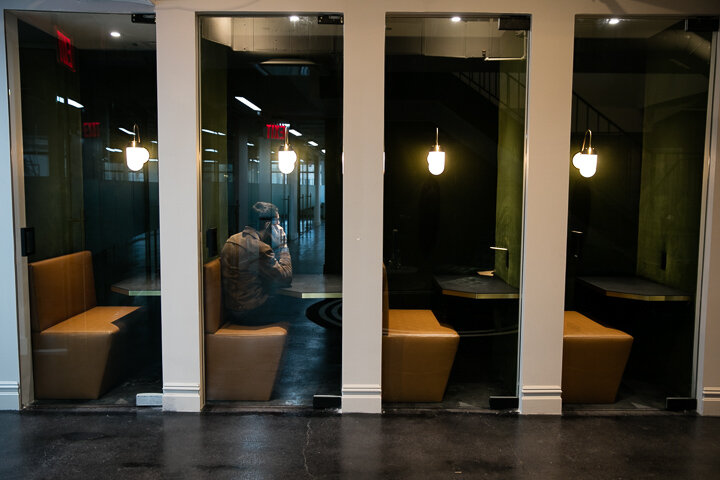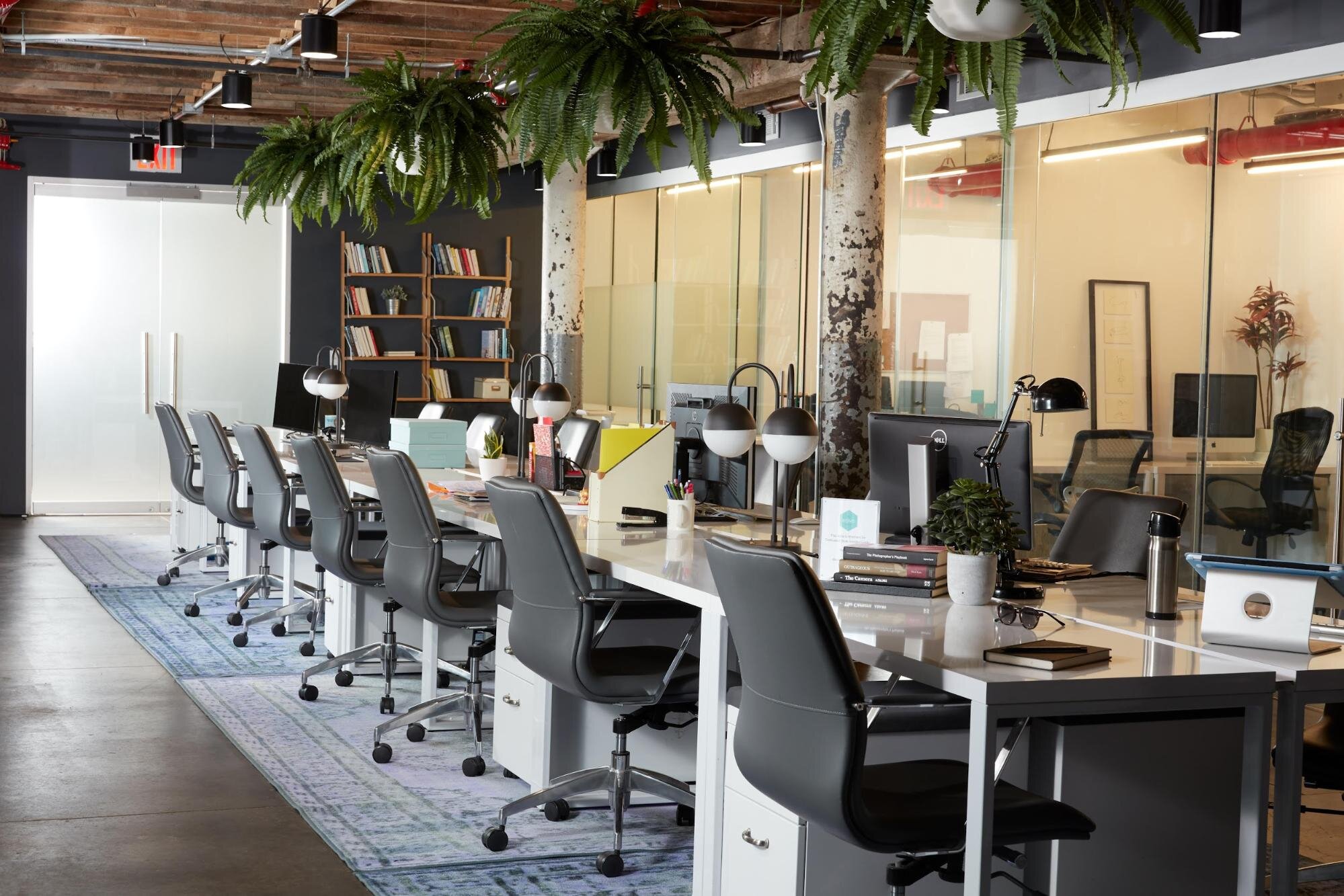By Bond Collective Staff
The concept of the hybrid workplace has been around for years. The vast majority of businesses, though, were slow to embrace it for two very clear-cut reasons:
-
The technology to support it really hadn’t arrived yet
-
Management had no idea how it would affect productivity
In the wake of recent events — during which most businesses faced the choice to embrace remote work or close their doors completely — technology caught up and the business world discovered that it could maintain productivity regardless of where employees worked.
Now, the hybrid workplace is rapidly becoming the norm for businesses of all types and sizes.
In this article, we discuss the future of work and how your business can implement a hybrid workplace of its own.
The Hybrid Workplace Defined
A hybrid workplace is one that supports both in-office workers and remote workers alike.
This lies in sharp contrast to the more traditional workplace arrangement that gives more support to the in-office workers than it does to those who are part of the remote workforce.
In addition, modern hybrid workplaces revolve around three fundamental concepts:
-
Workers don’t necessarily have to schedule where they work in advance
-
Unlike the traditional work arrangement, the number of in-office workers doesn’t always exceed the number of virtual workers
-
The ratio of remote employees to in-office employees is not static and will shift from hour to hour, day to day, and week to week
This transition away from the common concept of one employee, one assigned desk toward a more fluid and flexible workplace design lies at the heart of it all and demands that businesses change the way they think about their offices and how their teams work.
We’ll discuss this idea further in the How To Create A Hybrid Workplace section below.
But first, we’ll delve a bit deeper into the theory of the hybrid workplace and how it provides an adjustable framework that governs the way businesses work.
The Theory Behind The Hybrid Workplace
While the concept of the hybrid workplace has been around for years and is fairly straightforward — an arrangement that provides equal support for in-office and remote workers — the theory behind it has undergone a radical shift in recent months.
Now, the concept has come to embody and represent the dual ideas of flexibility and adjustability — both in the physical workplace itself and in the way the business operates on a day-to-day basis.
In the physical sense, modern hybrid workplaces focus less on individual workstations and more on collaboration spaces where both in-office and remote employees can gather and work together.
In the operational sense, modern hybrid workplaces are adjustable to the overall needs of the business and allow them to customize how and where employees work at a moment’s notice.
Microsoft, for example, recently implemented a model that can change from day to day to accommodate the needs of the business, the needs of its employees, and the external conditions that might affect them.
Stage six is all open and on-site. Stage five is open with restrictions. Stage four is a soft open. Stage three is work from home strongly encouraged (during stages three, four, and five, employees are encouraged to work remotely).
Finally, stage two is mandatory work from home, and stage one is closed.
Your business may not need to go as deep into the theory and philosophy of the hybrid workplace as Microsoft has, but implementing the physical aspects of the concept — a flexible workspace that facilitates in-person and remote collaboration — is certainly worth investigating.
How To Create A Hybrid Workplace
1) Use Technology To Drive The Hybrid Workplace
Technology is at the heart of the hybrid workplace because remote work all but demands internet-based collaboration tools.
The transition from on-site data storage and processing to cloud-based storage and processing means that teams can work together in real time no matter where in the world individual employees are located.
2) Create One-On-One Spaces
In addition to collaboration spaces where the whole team can work together, the hybrid workplace incorporates one-on-one spaces where in-office employees can talk privately with their remote colleagues.
These one-on-one spaces may be as small as a telephone booth with nothing more than a chair and a table, or as large as a restaurant booth with bench seats and a table in-between.
Regardless of the size, one-on-one spaces are completely enclosed and are soundproof so that team members can conduct confidential meetings in private.
3) Invest In Video Conferencing Tools
We talked earlier about how technology as a general concept drives the hybrid workplace. But not just any old technology will do.
Your business and your team will need specific tools in order to make the hybrid workplace a reality. Video conferencing tools are the first step.
These apps allow anyone with an internet connection to meet, talk, and work together regardless of where they choose to work. Some employees may be in the office while other team members work remotely.
With video conferencing tools, it doesn’t matter — everyone can gather in one place (on one screen) to brainstorm, collaborate, and get things done.
4) Make Online Collaboration Tools Part Of Your Workflow
Another key component of the hybrid workplace is collaboration software.
This is slightly different from video conferencing software in that it allows your team to organize the workflow, communicate in real time, track changes in documents and spreadsheets, and minimize the confusion of multiple individuals working on the same task from different locations.
Apps such as Slack, Trello, Google Workspace, and many more make it easy to collaborate whether your team is together in the office or all working from different locations.
5) Try Hot Desking
As we mentioned at the beginning of the article, the traditional office model revolves around the concept of one employee, one desk.
When an employee starts work at your business, you assign them a space of their own and they report there every day.
The hybrid model is completely different because some team members may only report to the office two or three times a week, while others may always work remotely. If you assigned desks to these team members, you’d end up with a lot of unused space.
That’s where hot desking comes in. In hot desking, team members occupy workspaces on a first-come, first-served basis.
Desks, tables, and chairs have no permanent “owner,” and employees use whatever is available that fits their needs when they arrive.
This seating model requires implementing some sort of reservation and tracking system, but check-in and check-out software makes hot desking simple, efficient, and effective.
6) Offer Hoteling
Hoteling is similar to hot desking but different in one key aspect: workspaces are reserved ahead of time — typically for longer durations of several days, a week, or a month.
If a remote team member knows they will be in town for a week and would like the security and consistency of the same desk day after day, hoteling is the perfect solution.
Like hot desking, hoteling only works if you pair it with a reservation and tracking system that is easy to use and accessible to all anytime, day or night.
7) Train Your Team To Work Remotely
One of the cornerstones of the hybrid workplace is training your team to work remotely.
And while many people think of remote work as happening at home, it’s actually an arrangement in which an employee or group of employees works mainly from an alternate location and communicates with the company via email, telephone, or other digital medium.
The transition from in-office work to remote work does take some getting used to, however, and all of your team can benefit from training in this regard.
The most effective training focuses on two key aspects: technology and best practices.
Working within the hybrid workplace model requires that your team masters new technologies and tools that make the job possible. That may require extensive training.
Similarly, working remotely involves a new set of best practices that might be foreign to your team. Train your employees to apply your business’s core values, culture, and standards to their work, wherever they may set their laptop.
For more information on managing a remote team, check out these helpful articles from the Bond Collective blog:
8) Experiment With Innovation Spaces
In simplest terms, innovation is the practical implementation of ideas that result in the introduction of new goods, services, or the method by which those goods and services are offered.
Innovation is very different from the regular, day-to-day work on which your team mainly focuses, and it takes a significant shift in thinking to move from one to the other.
To facilitate that shift, set up an innovation space where the sole activity is to come up with new ways to make your product, service, or business better.
Design said space to encourage creativity, communication, and the exchange of ideas, and provide plenty of tools — computers, connectivity, whiteboards, etc. — to make moving from inspiration to reality easy.
For more on whether an innovation space can work for your business, take a few minutes to read this article from the Bond Collective blog: What Are Innovation Spaces And Can They Work For Your Business?
9) Encourage The Work-From-Anywhere Model
As we mentioned earlier in this article, a major component of the hybrid workplace is the fact that team members no longer have to report to a central office every day. They can literally work from anywhere.
While many may choose to work from home, others may find inspiration in a booth at their local coffee shop, on a bench in the park, or on a blanket down by the river.
And while that may be a big switch for employees, it’s a big switch for employers, too. But, more and more businesses are coming to the realization that their team can maintain productivity, creativity, and collaboration even under this new work-from-anywhere (WFA) model.
Where the hybrid workplace is concerned, WFA practices may involve rearranging standard operating procedures so that team members report to the office in person once or twice a week, but are then allowed to work from home (or anywhere they like) on the other days.
It all depends on what’s right for the business and what goals it hopes to reach with a hybrid workplace/work-from-anywhere program.
Again, this may take some getting used to — for both employees and employers alike — and your managers may have to repeatedly encourage the transition from the traditional work standard to the WFA model so that your team feels comfortable with the change.
For more details on establishing a work-from-anywhere model in your business, take a few minutes to read this article from the Bond Collective blog: Is The Work-From-Anywhere Model Here To Stay?
10) Embrace The Future
The traditional business model is slow-moving and, in many ways, resistant to change. The hybrid workplace, however, embraces the future and makes use of new technologies whenever they benefit the team.
Innovations such as secure group messaging, virtual reality, smart virtual assistant apps, and the cloud are changing the way entire industries do business. Will your business keep up?
To stay competitive in such a fast-paced environment, managers and owners alike need to think differently — embrace the future, as it were — and be more open to the change that innovation brings.
For more on how technology is transforming business and how your business can adapt, check out this article from the Bond Collective blog: 10 Ways Technology In The Workplace Is Transforming Business.
11) Implement A Floorplan To Boost Productivity
Under the hybrid workplace model, not everyone will report to your office every day. With less need to provide workspace for all of your team, your business can implement a floorplan to boost productivity.
You’ll now have more space to focus on accessibility, create quiet areas, and add plants to your workspace. You can also take the opportunity to rearrange in order to provide more natural light to each workstation or incorporate standing desks into the design.
All of these changes can mean a boost in productivity that is good for you, your team, and your business.
12) Go Paperless In The Hybrid Workplace
In many ways, digital storage and the cloud have rendered many of the old filing and data-access practices obsolete.
Gone is the need for hardcopy, the rows and rows of filing cabinets to hold said paper, and the massive spaces to keep those filing cabinets organized. What’s more, the hybrid workplace all but demands that your business transition to a paperless paradigm.
By storing your information in the cloud, you make it possible for your employees to access documents — and even specialized apps — anywhere, anytime.
Your team doesn’t need the hardcopy and computers at your central location to do their job. Everything is online in the cloud.
13) Automate Common Tasks With The IoT
The hybrid workplace is built on the idea that there will be fewer employees in the office at any given time.
Unfortunately, that means there will be fewer people in the office to take care of common tasks such as monitoring the toner in the printer, stocking the refrigerator, and refilling the paper in the copy machine.
That’s where the Internet of Things (IoT) comes in. IoT allows appliances, tools, and furniture to do things they’ve never been able to do before.
Technology such as refrigerators, lights, stoves, and cutting boards (yes, cutting boards) that have, in the past, been isolated from one another, are now coming online and working together.
Refrigerators that notify you when the milk is low and cutting boards that display recipe instructions are already a reality. But imagine office lights that you can program with your computer, tablet, or smartphone to dim and change color just as sunlight does.
Or think how much time you’ll save doing inventory if your supply-room shelves notify you when you’re low on toner and printer paper.
That’s how the Internet of Things is working hand in hand with the hybrid workplace model to transform the offices of the 20th century into futuristic offices for the 21st and 22nd century.
14) Learn To Manage A Remote Workforce
In many regards, making the hybrid workplace model successful means that managers have to learn new ways of doing their job.
First and foremost is learning to manage a remote workforce that you don’t see face-to-face every day. How can entrepreneurs and executives of all types learn this vital skill?
Here are some tips to get you started:
-
Create core values
-
Standardize the way your team works
-
Encourage consistency
-
Allow for flexibility
-
Make expectations and responsibilities clear
-
Measure performance through deliverables
For more suggestions on how to manage a hybrid team in the 21st century, check out this article from the Bond Collective blog: How To Manage A Remote Workforce From Anywhere With Internet Access.
15) Focus On Hybrid Workplace Inclusion
With a significant portion of your team working offsite at any given time, inclusion in the hybrid workplace becomes more important than ever.
Inclusion encompasses the practices and attitudes of a business that ensures all team members:
-
Have equal access to the same resources and opportunities
-
Are treated fairly and respectfully
-
Can (and want to) contribute fully to the team’s and the business’s success
In simpler terms, workplace inclusion stresses the fact that the thoughts, ideas, and perspectives of all individuals matter and that your business considers every point of view before it makes a decision.
When members of your team don’t see each other every day, building a culture of inclusivity — be it in a traditional office or a hybrid workplace — can be difficult. The benefits, however, are well worth the effort.
The Hybrid Workplace Is Available Now
Creating a hybrid workplace from scratch can be a difficult and expensive undertaking. But when you partner with Bond Collective, we do all the work for you.
For years, Bond Collective has provided the business world with coworking spaces (the precursor of the hybrid workplace) for individuals, teams, and entire businesses.
Whether you need a private office, a suite of offices, a dedicated desk, or just a place to sit and type, you’ll find it at any one of the many Bond Collective locations across the country.
It doesn’t matter if you’re a team of one or 100, you’ll enjoy all that Bond Collective has to offer, including industry-leading amenities such as:
-
Conference rooms for 2 or 20+
-
Custom build-outs
-
Private meeting and phone booths
-
Guest reception and greeting
-
Professional environment
-
Unlimited black-and-white printing
-
Fast, reliable WiFi
-
Mail and package handling
-
Porter service
-
Nightly office cleaning
-
Fresh fruit, snacks, and weekly breakfast
-
Complimentary spa water, craft beer, and coffee
Visit any one of Bond Collective’s many locations in the United States — including workspaces in California, New York, Pennsylvania, Washington D.C., Illinois, Tennessee, and Texas — to see what the best hybrid workplace is all about.








